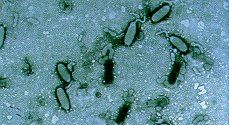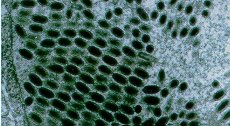Aquaculture Pathology Program Focuses on Shrimp
Practical assistance for the worldwide shrimp industry
Far from the ocean, in the heart of the Sonoran Desert, Donald Lightner
and his staff in the Aquaculture Pathology Program diagnose and research
shrimp diseases. The ideal geographic location of the UA, isolated from
coastal waters, reduces to near zero the risk of accidental introduction
of shrimp pathogens into the aquatic environment.
 "Our
main goal is to describe diseases of farm-raised shrimp and to develop
diagnostic methods for these diseases using traditional and modern molecular
techniques," says Lightner, who is one of the world's foremost authorities
on shrimp pathology. "After we recognize what the problem is and put
a name on it, and develop an accurate diagnostic method, we do research
on prevention and control methods as well." These include methods for
developing specific pathogen-free (SPF) or specific pathogen-resistant
stocks (SPR). "Our
main goal is to describe diseases of farm-raised shrimp and to develop
diagnostic methods for these diseases using traditional and modern molecular
techniques," says Lightner, who is one of the world's foremost authorities
on shrimp pathology. "After we recognize what the problem is and put
a name on it, and develop an accurate diagnostic method, we do research
on prevention and control methods as well." These include methods for
developing specific pathogen-free (SPF) or specific pathogen-resistant
stocks (SPR).
The aquaculture pathology program includes both an on-campus laboratory
and a primary quarantine facility located at the West Campus Agricultural
Center in Tucson, which acquires wild or farmed shrimp and assesses
the disease status of these potentially SPF and SPR stocks. High standards
of care and handling throughout the duration of the testing period,
which can take many months, are necessary to assure the specific pathogen-free
state of the animals.
The UA provides expert assistance to governments and to the shrimp
farming industry with a variety of diagnostic techniques, including
microbiological and histological identification of the disease process,
electron microscopic examination of newly recognized shrimp pathogens,
as well as other standard diagnostic methods. The UA has also pioneered
the use of molecular (DNA-based) technology in the study of shrimp diseases.
In particular, researchers have prepared gene probes to several serious
viral pathogens and have devised techniques for their use in diagnosis.
The transfer of this technology to the private sector has led to the
development of gene probe kits that can be used in diagnostic laboratories
and in the field (at shrimp farms and hatcheries). Such gene probe kits
provide to the shrimp farming industry much more rapid and sensitive
tools for detecting pathogens than were available with traditional methods
like histology and live animal bioassays.
Shrimp production worldwide has increased steadily since the 1980s,
and now nearly a third of the world supply comes from farms. Most of
the product is imported by the U.S., Japan and Western Europe. Shrimp
diseases have also become more widespread in the industry, resulting
in annual losses since 1992 averaging nearly one billion dollars.
"Bacterial and viral diseases are the most common, with viral diseases
causing the most economic damage," Lightner says. "None of these viral
diseases are a threat to humans and the bacterial diseases are only
a threat if improperly processed shrimp are consumed raw."
 The
UA became involved in shrimp aquaculture during the early 1970s through
experimental programs conducted in Mexico in connection with desalinization
projects. The UA is the closest U.S. university to the Gulf of California
in Mexico. Near Puerto Penasco, Mexico, UA faculty and staff assisted
in the development of super-intensive shrimp farming methods to increase
production under controlled environmental conditions, including raising
SPF shrimp in seawater-filled "raceways" placed within plastic-covered
greenhouses. With this technology, the UA produced market-sized shrimp
at a commercial prototype farm in Hawaii at higher stocking densities
than have been achieved since, anywhere else in the world. The
UA became involved in shrimp aquaculture during the early 1970s through
experimental programs conducted in Mexico in connection with desalinization
projects. The UA is the closest U.S. university to the Gulf of California
in Mexico. Near Puerto Penasco, Mexico, UA faculty and staff assisted
in the development of super-intensive shrimp farming methods to increase
production under controlled environmental conditions, including raising
SPF shrimp in seawater-filled "raceways" placed within plastic-covered
greenhouses. With this technology, the UA produced market-sized shrimp
at a commercial prototype farm in Hawaii at higher stocking densities
than have been achieved since, anywhere else in the world.
In 1987, the UA was invited to join a USDA-funded consortium with
five other institutions to assist in developing the domestic shrimp
culture industry and to reduce the U.S. trade deficit that is now over
two billion dollars annually in imported shrimp. As part of the Gulf
Coast Marine Shrimp Farming Consortium, the aquaculture pathology program
at the UA is working to provide a healthy (SPF and SPR) seed stock supply
for the industry, to assist in disease control, and to address the environmental
aspects and regulations of shrimp aquaculture for continued growth of
the U.S. industry.
"Because there is no treatment for the viral diseases," Lightner says,
"most of our work centers on detection and avoidance, or on the development
of SPF and SPR stocks. Because of FDA regulations, the treatments available
for treating bacterial diseases of shrimp are very limited. So, we work
with farmers to change farm practices, and when permitted by FDA, to
test certain types of chemotherapuents (for efficacy, food safety, and
environmental effect) in controlling bacterial disease. We also help
select the breeding stocks and test them for their health (SPF and SPR)
status."
For the past ten years, the aquaculture faculty and staff have conducted
a shrimp pathology short course during the summer session. Since the
first offering of this course, 501 students from the U.S. and 45 other
countries have attended, from industry, academia, and government-related
agencies. This course includes training in the most up-to-date methods
for the diagnosis of shrimp diseases. In addition to the short course,
the aquaculture pathology laboratory offers shrimp disease services
to industry through workshops, a diagnostic laboratory and post-graduate
research programs.
In May, 1994, Lightner's laboratory was designated one of two reference
laboratories in the world for crustacean pathogens by the Office of
International Epizootics headquartered in Paris, France.
Many individuals at the UA are involved in these aquaculture pathology
programs. In particular, Lightner's laboratory includes professional
staff as well as graduate students who all actively participate in the
diagnostic, educational and research aspects of the program.
Article written by Susan McGinley, Wanda McCormack
and Bonnie T. Poulos, ECAT, College of Agriculture
This is part of the 1997 Arizona Experiment Station Research Report
This document is located at http://ag.arizona.edu/pubs/general/resrpt1997/aquaculture.html
Return to Index for 1997 report
Researcher:
Donald Lightner
Department of Veterinary Sciences and Microbiology
(520) 621-8414
aquapath@vetsci.microvet.arizona.edu
|